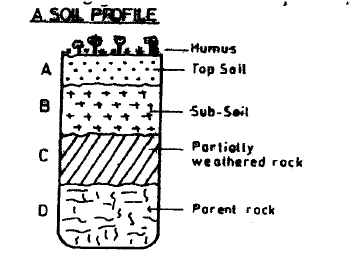A i what is soil catena ii draw a labeled diagram to show a well
Table of Contents
Table of Contents
If you’re studying soil mechanics, one concept that you’ll need to master is how to draw a flow net diagram. This technique is essential for visualizing groundwater movement and can help you design structures that can withstand the forces acting on them. But figuring out how to create a flow net can be intimidating, especially if you’re new to the subject. In this post, we’ll walk you through the steps to create a flow net diagram in soil mechanics from start to finish.
The potential struggles of how to draw a flow net diagram soil mechanics
Flow net diagrams can be challenging to construct, even for experienced soil mechanics engineers. If you’re just starting with this technique, you may struggle to wrap your head around the principles involved. Some of the most common pain points include figuring out how to balance the flow through the structure, understanding the significance of the spacing between the flow lines, and interpreting the results of the diagram.
The answer to how to draw a flow net diagram soil mechanics
The good news is that drawing a flow net diagram in soil mechanics doesn’t have to be complex. With the right knowledge and technique, you can create an effective diagram that accurately represents the flow of groundwater through your structure. Keep in mind that this process involves careful planning and calculations, so it’s essential to take your time and be thorough in your work.
Summary of how to draw a flow net diagram soil mechanics
In summary, a flow net diagram is a tool that soil mechanics engineers use to understand the movement of groundwater through a structure. The technique can be challenging at first, but with practice and patience, you can become proficient in creating these diagrams. In this post, we’ll guide you through the process of creating a flow net diagram, addressing common pain points, and providing tips for success.
Why Draw a Flow Net Diagram in Soil Mechanics?
Before you start drawing your flow net diagram, it’s essential to understand why this technique is essential in soil mechanics. Groundwater movement can be difficult to predict and can have significant effects on structures like dams and building foundations. A flow net diagram provides engineers with a visual representation of how groundwater is moving through a structure, allowing them to design structures that can withstand these forces.
When I was first learning about how to draw a flow net diagram, I struggled to see the practical applications of the technique. But after working on a few projects where groundwater movement was a significant concern, I quickly realized how valuable this tool can be.
The Basics of Creating a Flow Net Diagram
To create an accurate flow net diagram, you’ll need to follow a few basic steps:
- Start by drawing a scaled diagram of the structure you’re analyzing.
- Identify the points where groundwater enters and exits the structure.
- Determine the head difference between the entry and exit points.
- Draw a grid over your diagram that’s perpendicular to the flow direction.
- Sketch in flow lines that pass through the entry and exit points on your diagram.
- Calculate the spacing between the flow lines based on the head difference and hydraulic conductivity of the soil.
- Draw equipotential lines that cross all of the flow lines at right angles.
- Calculate the spacing between the equipotential lines based on the hydraulic conductivity of the soil.
- Interpret the diagram based on the density and spacing of the flow and equipotential lines.
Remember that creating a flow net diagram in soil mechanics takes practice, and it’s essential to double-check your work at every stage to ensure accuracy.
The Importance of Good Data in Flow Net Diagrams
One critical component of creating a flow net diagram in soil mechanics is having access to accurate data. You’ll need to understand the hydraulic conductivity of the soil you’re working with and measure the head difference between the entry and exit points. Any errors in your data can cause significant accuracy issues in your diagram, so it’s crucial to take the time to gather reliable information.
The Benefits of Learning how to draw a flow net diagram in Soil Mechanics
Learning how to draw a flow net diagram can be time-consuming, but it’s an essential tool for any engineer who works with structures exposed to groundwater. These diagrams can help you design structures that are safe, stable, and sustainable, reducing the risk of failure and ensuring that your projects remain structurally sound for years to come.
Q&A section about How to draw a flow net diagram in Soil Mechanics
1. What is the purpose of a flow net diagram in soil mechanics?
A flow net diagram is a tool that soil mechanics engineers use to understand the movement of groundwater through a structure. The technique can be challenging at first but provides engineers with a visual representation of how groundwater is moving through a structure, allowing them to design structures that can withstand these forces.
2. How can I ensure the accuracy of my flow net diagram?
Creating a flow net diagram in soil mechanics takes practice, and it’s crucial to double-check your work at every stage to ensure accuracy. One critical component of creating a flow net diagram is having access to accurate data, understanding the hydraulic conductivity of the soil you’re working with, and measuring the head difference between the entry and exit points.
3. Do I need specific software to draw a flow net diagram?
You don’t need any specific software to draw a flow net diagram in soil mechanics. All you need is a scale diagram of the structure you’re analyzing, access to accurate data, and the ability to perform calculations accurately.
4. How can I learn more about how to draw a flow net diagram in soil mechanics?
There are many resources available to help you learn how to draw a flow net diagram in soil mechanics. Some useful materials include textbooks on soil mechanics, online courses, and hands-on workshops. Practice is the best way to master this technique, so make sure you’re regularly practicing and reviewing your work.
Conclusion of how to draw a flow net diagram soil mechanics
Creating a flow net diagram in soil mechanics may seem intimidating at first, but with practice and patience, you can master this essential tool. By following the basic steps outlined in this post and taking the time to gather reliable data, you can create an accurate representation of groundwater movement through your structure. As with any engineering tool, it’s essential to be thorough and double-check your work at every stage to ensure the best possible results.
Gallery
Flow Net Construction By Graphical Method

Photo Credit by: bing.com /
Soil Mechanics - 1.3 Flow Net - Example 2 - YouTube

Photo Credit by: bing.com /
Soil Mechanics - 1.1 Flow Net -Sheet Pile - YouTube

Photo Credit by: bing.com / pile
How To Draw Flow Net Seepage By Hand - Soil Mechanics - Euro Guide

Photo Credit by: bing.com /
A) (i) What Is Soil Catena? (ii) Draw A Labeled Diagram To Show A Well

Photo Credit by: bing.com / soil catena soils describe arid






